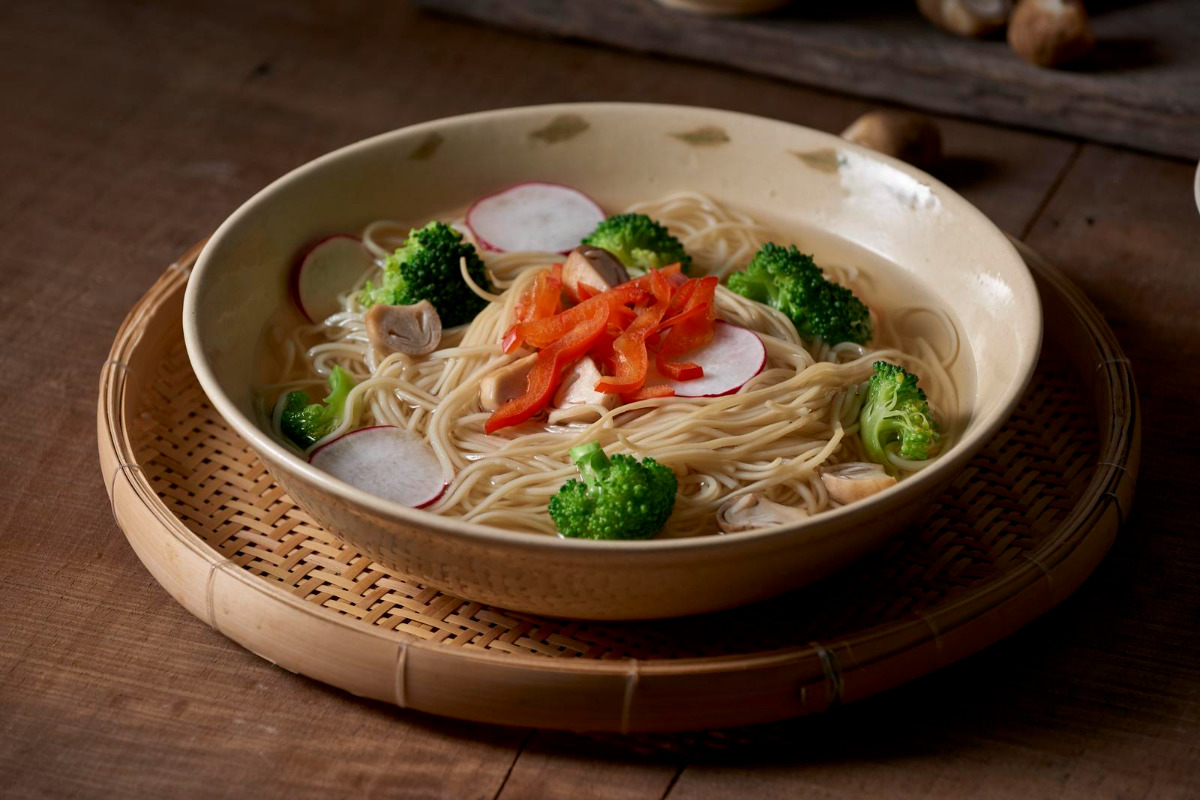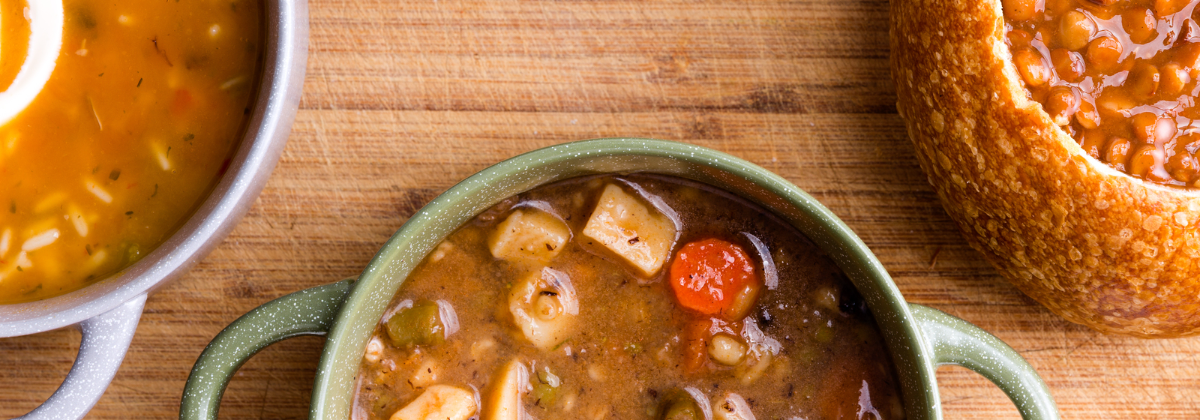Making a delicious soup is a talent. The best sides for soup and the best things to top soup with can all make for a tasty soup. However, adding the best type of noodles can make for the best soup fusion of flavors. But which to pick? Well, I’ve taken the best noodles to use in any soup. You can use ramen, udon, soba, and rice noodles in your soup. But this isn’t all! So, let’s go over all the noodles and types of soup you can use them with.

💡 Best Noodles for Soup
Ramen Noodles
Ramen noodles are the go-to choice for soups, thanks to their usability and texture. They’re made from wheat flour, water, and kansui. This is an alkaline mineral water that gives the noodles their distinct yellow color and chewy texture.
Here are two soups that can be used with ramen noodles:
Chicken Broth Soup: Ramen noodles do great in adding a satisfying texture to chicken broth soup. Their versatility allows them to absorb the flavors of the broth while maintaining their chewiness.
Ramen Noodle Mushroom Soup: These noodles can really match the earthy flavor of mushroom soup. Their firm texture absorbs the savory essence of the mushrooms and broth, creating a comforting and flavorful soup that’s just perfect.
Udon Noodles
Udon noodles are thick Japanese noodles made with wheat flour. They’re a great option for soups thanks to a soft, chewy texture and a mild taste. You can buy these noodles dried, fresh, or frozen.
Here are two soups that can be used with udon noodles:
Chicken Udon Soup: In Chicken Udon Soup, the thick, chewy udon noodles perfectly take up the savory broth. Paired with the ingredients, these noodles really amp up the flavor profile and really help thicken the soup.
Tempura Udon Soup: In Tempura Udon Soup, the soft udon noodles give a comforting base for the crispy tempura batter. This creates a delightful contrast in texture with the savoriness of the soup.
Soba Noodles
Soba noodles are thin and chewy Japanese noodles made from buckwheat flour. They have a nutty flavor and are a great choice for soups because they hold up well in hot liquids. Soba noodles are also a good source of protein, fiber, and minerals such as manganese, thiamine, and magnesium.
Here are two soups that can be used with soba noodles:
Miso Soba Soup: Soba noodles really complement the earthy flavor of miso and add a satisfying texture to the soup. Their nutty taste and firm texture enhance the overall balance of flavors in the dish.
Spicy Peanut Soba Soup: These chewy noodles soak up the spicy peanut broth well, providing a tasty base and texture for the soup. Their slight nuttiness adds a delightful balance to the heat of the broth.
Rice Noodles
Rice noodles are the choice for soups that need that light and delicate touch. They’re easy to cook and can be used in tons of soups, from simple broths to thicker and heavier soups. These noodles are made from rice flour and water and come in sizes ranging from thin vermicelli to flat pad Thai noodles.
Here are two soups that can be used with rice noodles:
Pho: This classic Vietnamese soup features thin, flat-shaped rice noodles. Perfect for soaking up the flavorful broth and complementing the tender beef or chicken used in the soup.
Tom Yum: This spicy and sour Thai soup works well with thin rice noodles. They help balance out the flavors of the soup and soak up the spicy broth.
Egg Noodles
Egg noodles are a superb choice for soup, thanks to their rich and unique flavor. They’re made with a higher egg-to-wheat ratio than traditional pasta. This gives them a richer taste and a firmer texture that holds up well in soup broth.
Here are two soups that can be used with egg noodles:
Classic Chicken Noodle Soup: Egg noodles in a classic chicken noodle soup complement the tender chunks of chicken and aromatic vegetables. Their slightly chewy consistency gives a satisfying bite.
Beef Stroganoff Soup: In Beef Stroganoff Soup, egg noodles serve as the perfect base. They absorb the creamy broth infused with tender beef, mushrooms, and onions. They match the delicious richness of the soup.
Shirataki noodles
Shirataki noodles are translucent, gelatinous noodles made from the konjac yam. They have a chewy texture and are low in calories and carbohydrates. A fantastic and popular choice for those into low-carb and keto diets.
Here are two soups that can be used with Shirataki noodles:
Sukiyaki: A Japanese hot pot dish featuring thinly sliced beef, vegetables, and other ingredients cooked in a sweet and savory broth. Shirataki noodles are added to the simmering broth, absorbing the rich flavors while providing a tastier texture to the dish.
Soondubu Jjigae (Korean Spicy Tofu Soup): This is a Korean stew made with soft tofu, vegetables, seafood, and sometimes meat, cooked in a spicy and flavorful broth typically made with gochujang and gochugaru. Shirataki noodles are used in the soup to soak up the bold spicy flavors.
Bean Thread Noodles
Bean thread noodles are a type of transparent noodle made from starch, such as mung bean starch, potato starch, or pea starch. They are thin, delicate, and have a slightly chewy texture that really shines in subtle soups
Here are two soups that can be used with bean thread noodles:
Vietnamese Pho with Bean Thread Noodles: Bean thread noodles provide a light and slippery texture to the iconic pho soup. The transparent strands absorb the aromatic flavors of the broth, perfectly complementing the dish.
Chinese Hot and Sour Soup with Bean Thread Noodles: These noodles offer a unique twist to the classic Chinese hot and sour soup. They provide a delicate and silky base that absorbs the spicy and tangy flavors of the broth.
🧐 Frequently Asked Questions
You can’t go wrong with whole-grain noodles. They are high in fiber and have a lower glycemic index. Brown rice noodles are also a good option for those who are gluten-free.
For vegetarian soups, you can use a variety of noodles, such as soba noodles, udon noodles, and rice noodles. Try using soba noodles in a miso soup, udon noodles in a vegetable soup, and rice noodles in a Thai-inspired soup.
Ramen noodles are a popular choice for soups, especially those with a rich and flavorful broth. Soba noodles and udon noodles follow close behind. Try using ramen noodles in a spicy miso soup, soba noodles in a cold soba noodle soup, and udon noodles in a hot and sour soup.
Thin noodles like vermicelli and angel hair are good options, as are egg noodles and rice noodles. Try using vermicelli noodles in a pho soup, angel hair noodles in a tomato soup, and rice noodles in a chicken and vegetable soup.
